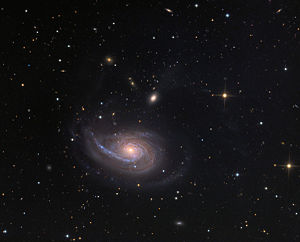NGC 770
| Galaxy NGC 770 |
|
|---|---|

|
|
| NGC 772, above NGC 770. Image taken with a 60 cm telescope | |
| AladinLite | |
| Constellation | Aries |
|
Position equinox : J2000.0 , epoch : J2000.0 |
|
| Right ascension | 01 h 59 m 13.6 s |
| declination | 18 ° 57 ′ 17 ″ |
| Appearance | |
| Morphological type | E3 |
| Brightness (visual) | 13.0 likes |
| Brightness (B-band) | 14.0 mag |
| Angular expansion | 1.1 ′ × 0.8 ′ |
| Position angle | 15 ° |
| Surface brightness | 12.9 mag / arcmin² |
| Physical data | |
| Redshift | 0.008483 ± 0.000017 |
| Radial velocity | 2543 ± 107 km / s |
|
Stroke distance v rad / H 0 |
(118 ± 8) · 10 6 ly (36.1 ± 2.5) Mpc |
| diameter | 40,000 ly |
| history | |
| discovery | RJ Mitchell |
| Discovery date | November 3, 1855 |
| Catalog names | |
| NGC 770 • UGC 1463 • PGC 7517 • CGCG 461-016 • MCG + 03-06-010 • 2MASX J01591364 + 1857169 • Arp 78 • GC 461/464 • | |
NGC 770 is an elliptical galaxy of Hubble type E3 in the constellation Aries . It is around 118 million light-years away from the Milky Way and has a diameter of around 40,000 light-years.
What is unusual about this object is that its core area rotates in the opposite direction to the outer areas. Since NGC 770 is gravitationally bound to NGC 772 , tidal forces could possibly be responsible.
The galaxy was discovered on November 3rd, 1855 by RJ Mitchell .
Web links
Commons : NGC 770 - collection of images, videos, and audio files
